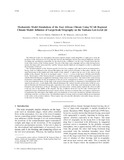Mechanistic model simulations of the East African climate using NCAR regional climate model: influence of large-scale orography on the Turkana low-level jet

View/
Date
2001-06Author
Indeje, Matayo
Semazzi, Fredrick H M
Xie, Lian
Ogallo, Laban J
Language
enMetadata
Show full item recordAbstract
The National Center for Atmospheric Research regional climate model (RegCM) is employed to study the
dynamics of the Turkana low-level jet that lies between the Ethiopian and the East African highlands, and also
investigate the mechanisms responsible for the observed dry conditions over the Lake Turkana basin that lies
in the wider section of the Turkana channel. The role of the large-scale orography and two other forcing factors
namely the large-scale monsoonal flow and the Turkana channel depth are investigated in order to understand
the kinematics of the jet.
The simulated patterns of the Turkana easterly low-level jet compares well with its observed characteristics.
Strong winds are indicated in the channel throughout the study period of October to December, with the wind
speed decreasing in the middle and wider region of the channel. A split in the jet core is also shown in the
middle of the channel. The level of maximum winds (
;
11 m s
2
1
) occurs in the layers 930-hPa and 650-hPa
levels. The dynamics of the Turkana channel is explained in terms of the orographic channeling effects associated
with the Bernoulli theorem as applied to barotropic steady and nonviscous flows. The main results on the forcing
mechanisms responsible for the development of the jet can be summarized as follows: (a) orographic forcing
is the most important factor, (b) the large-scale monsoon background flow is important in determining the wind
speed in the jet cores, (c) the depth of the channel determines the vertical structure and location of the jet cores,
and (d) thermal and frictional forcing play equivalent role as that of the large-scale background winds in the
formation and maintenance of the jet. Divergence and anticyclonic vorticity partly explains the observed split
in the jet cores in the middle of the channel. The dry conditions observed over the Lake Turkana basin are
explained in terms of dominant downward vertical velocity, decrease in moisture flux convergence, and increase
in temperature flux divergence that inhibit active developments of mesoscale circulations and their interactions
with large-scale flow over these areas. The identified regions of strong winds associated with the jet are important
to the safety in the aviation industry. These regions may also provide alternative renewable energy resources
in the form of wind energy
URI
http://journals.ametsoc.org/doi/pdf/10.1175/1520-0442%282001%29014%3C2710%3AMMSOTE%3E2.0.CO%3B2http://hdl.handle.net/11295/91118
Citation
Indeje, M., Semazzi, F. H., Xie, L., & Ogallo, L. J. (2001). Mechanistic model simulations of the East African climate using NCAR regional climate model: influence of large-scale orography on the Turkana low-level jet. Journal of climate, 14(12), 2710-2724.Publisher
University of Nairobi
